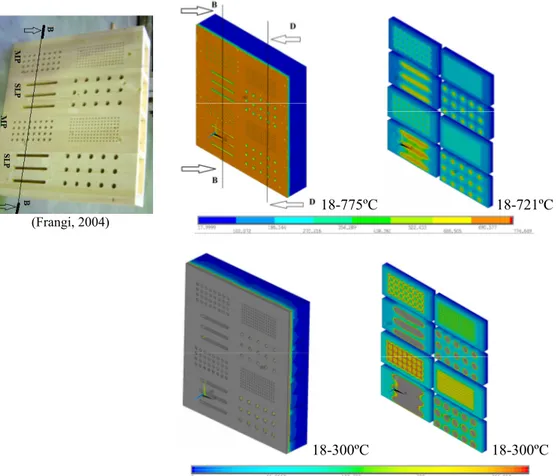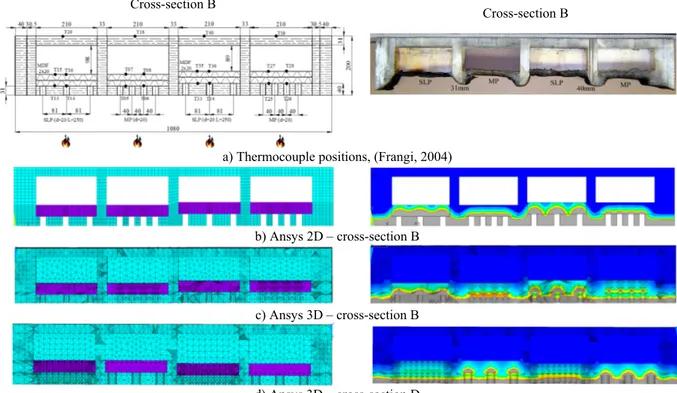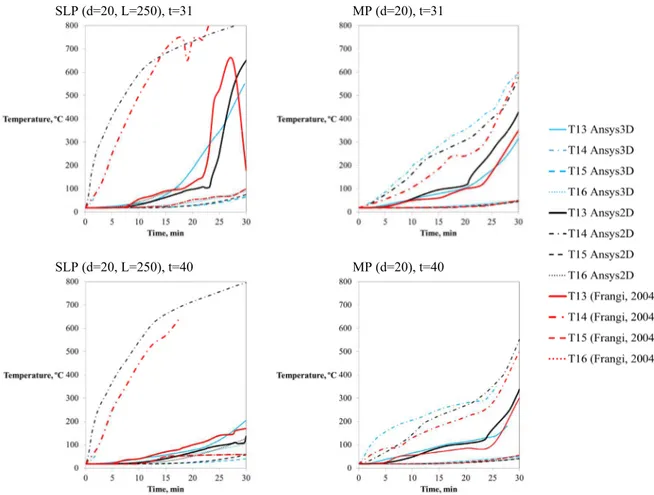PAPER REF: 4089
Please leave these first three lines blank for the Editors Please leave these first three lines blank for the Editors
NUMERICAL MODEL TO ASSESS THE FIRE BEHAVIOUR OF
CELLULAR WOOD SLABS WITH DRILLINGS
Please leave this line blank
E. M. M. Fonseca1(*); L. M. S. Barreira1; J. M. Meireles1; P. A. G. Piloto1 1
Polytechnic Institute of Bragança, Bragança, Portugal
(*)
Email: efonseca@ipb.pt
Please leave these two lines blank Please leave these two lines blank
ABSTRACT
The main goal of this paper is to develop a numerical model to assess the fire behaviour of cellular wood slabs with different drillings. A transient thermal analysis with nonlinear material behaviour will be solved with ANSYS program. The presented numerical model is based on a constructive solution proposed by Frangi and Fontana. The numerical results obtained will be compared with the experimental results from the reference. The developed numerical model allows future studies and simultaneously characterizes the effect of perforations in wooden slabs to minimize the fire risk. The numerical model can easily be adjusted for other constructive solutions, to facilitate the verification of fire safety, in buildings with several wood floors and slabs assemblies.
Keywords: cellular wood slab, fire, drilling, perforation.
INTRODUCTION
Wood is a natural material with good structural characteristics. Wood is strong in relation to its weight (Mackerle, 2005). Wood constructions are being widely used and the focus of this work is to present a typical cellular slab for floors or roofs assemblies. The cavities of these elements could be filled with insulation or wood-based fiberboards.
Different works have been presented by researchers presenting analytical methods and experimental procedures to evaluate the physical degradation of wood due to fire action (White, 1999), (Poon, 2003), (Janssens, 2004), (Frangi, 2004), (Fonseca, 2010, 2011, 2012).
When exposed to fire, wood produces a surrounding charring depth layer. This charcoal layer has no mechanical resistance and causes a reduction in the cross-section element, but otherwise slows the fire effect in the structure core. The size of the wood slabs and the provided insulation play an important role on fire safety. Also, the size of the perforations in wooden slabs could influence the heating effect though the thickness of the slab.
GEOMETRIC AND NUMERICAL MODEL
In this study a cellular wood slab was exposed to fire, using different types of drillings, and with internal fibreboard. As represented in the figure 1 there are many different applications of this type of elements in building construction, since wood ceiling, blank wall or laid deck.
Fig. 1 – Applications of cellular wood slab, ceilings and walls, with drillings.
Nowadays, it is usual all these type of applications due the attractive design, good acoustics, thermal comfort, among others of relevant characteristics. The perforations in the cellular wood slab could allow improving these characteristics and also permitting the maintenance of cables or other infrastructures.
Figure 2 represents different views of the geometric model based on the experimental model proposed by Frangi el al (Frangi, 2004). The model considers different cellular zones with different type and size of drillings (with rectangular and circular shapes). A 3D finite element (Solid70) with 8 nodes was used in Ansys program. Figure 2 also represents the mesh model used for transient thermal analysis.
Fig. 2 – 3D geometric model, cellular wood slab with drillings – fibreboard and mesh model.
The thermal properties of wood are function of the temperature and should be defined according the Eurocode 5 (CEN, 2003), see in figure 3. The density of the spruce wood material was considered equal to 450kg/m3 at room temperature. The effect of fire is considered using the appropriate boundary conditions due to convection and radiation. The temperature environment follows the standard fire ISO 834 curve, shown in figure 3.
Fig. 3 – Wood thermal properties and nominal fire curve (ISO 834).
RESULTS AND DISCUSSION
The cellular wood slab has different types of perforations with rectangular crack (SLP) and circular hollow (MP) at the bottom. The top surface of the slab is a solid wood with equal thickness. At the bottom surface, the cellular slab has different thicknesses equal to 31mm and 40mm, as represented in the cross-section B in figures 4 and 5. Into the cellular wood slab, the fibreboard insulation has the same thickness, with two overlapping plates of 20mm each. Figure 4 represents the temperature at one side fire exposure (bottom surface) of the cellular wood slab with insulation, using Ansys and the 3D finite element, at the end of 1800s.
(Frangi, 2004)
18-775ºC 18-721ºC
18-300ºC 18-300ºC
The effect of the drilling size is visible and produces a delay in the charring layer formation when the diameter is small size. The rectangular shape presents a charring layer at the end of 30min. The damage effect of fire is higher in the region of the slab with smaller wood thickness, as expected.
Figure 5 represents the temperature field at the end of 30min, and the residual cross-section representing the char layer formation at the bottom surface. Two different cross-sections B and D, as shown in figure 4, are analysed to represent the char layer formation.
Cross-section B
Cross-section B
a) Thermocouple positions, (Frangi, 2004)
b) Ansys 2D – cross-section B
c) Ansys 3D – cross-section B
d) Ansys 3D – cross-section D
Fig. 5 – Fire action at the end of 30min in cellular wood slab with fibreboard. a) Thermocouple positions and residual experimental cross-section B. b) Residual numerical cross-section with Ansys 2D. c) Residual numerical
cross-section B with Ansys 3D. d) Residual numerical cross-section D with Ansys 3D.
The numerical results are presented for the 3D model, with comparison between the 2D finite element (Fonseca et al, 2013) and the experimental tests (Frangi, 2004). The charred area represented has no effective resistance, producing a reduction in the resistance of the effective cross section. On the other hand, the charring depth depends on the time of fire exposure. In this case also depends of the MDF insulation material and the type of perforation. Cross-section B presents higher charred layer when compared with cross-Cross-section D.
The time temperature evolution was also compared, in particular thermocouple positions during 30 minutes. Figure 5a represents these points (Tk) and figure 6 represents the results
temperature. The perforations MP were compared with the SLP showing lower temperatures during 30min of fire exposure.
SLP (d=20, L=250), t=31 MP (d=20), t=31
SLP (d=20, L=250), t=40 MP (d=20), t=40
Fig. 6 – Time-temperature history in different nodal positions during 1800s.
CONCLUSIONS
Conclusions were presented and discussed about the importance of the temperature field obtained in wood cellular slab with perforations using a finite element modelling. The numerical method reveals good performance when compared with the experimental model. A 3D finite element model in transient thermal analyses was used. The results obtained are similar when compared with the experimental. It was found that in this kind of slab, the perforation type can limit the use of these elements in terms of fire resistance. In case of fire exposure at one side with perforations, the type and size of perforations should be chosen before, to prevent and delay the heating effect, allowing that the slab could remain in service during more time.
REFERENCES
E.M.M. Fonseca; L. Barreira, Experimental and Numerical Method for Determining Wood Char-Layer at High Temperatures due an Anaerobic Heating, International Journal of Safety and Security Engineering, Vol.1/1, pp.65-76, On-Line ISSN:2041-904X, 2011.
E.M.M. Fonseca, D.C.S. Coelho, L.M.S. Barreira, Structural safety in wooden beams under thermal and mechanical loading conditions, International Journal of Safety and Security Engineering, Vol.2/3, pp.242-255, ISSN:2041-9031 (paper format), ISSN:2041-904X (online), 2012.
Elza M.M. Fonseca, Luisa M.S. Barreira, Jorge M. Meireles, Paulo A.G. Piloto, Avaliação numérica da ação do fogo em coberturas de madeira com cavidades e perfurações, 3.as Jornadas de Segurança aos Incêndios Urbanos, Coimbra, Portugal, 2013.
EN1995-1-2: 2003. Eurocode 5: Design of timber structures - Part 1-2: Structural fire design. CEN - Comité Euron.CEN - Comité Européen de Normalisation, 2003.
ISO/FDIS 10456:2007(E) Building materials and products – Hygrothermal properties – Tabulated design values and procedures for determining declared and design thermal values, International Standard, ISO 2007.
EN316: 1999 E: Wood fibreboard. Definition, classification and symbols. CEN - Comité Euron.CEN - Comité Européen de Normalisation, 1999.
Frangi A, Fontana M., Untersuchungen zum Brandverhalten von Holzdecken aus Hohlkastenelementen. Institut für Baustatik und Konstruktion, Zurich, 2004.
Janssens M.L. Modeling of the thermal degradation of structural wood members exposed to fire. Fire and Materials, Vol. 28, pp.199-207, 2004.
Mackerle J., Finite element analyses in wood research: a bibliography, Wood Sci Technol Vol.39, pp.579–600, 2005.
Poon L., England J.P., Literature Review on the Contribution of Fire Resistant Timber Construction to Heat Release Rate – Timber Development Association, Warrington Fire Research Aust. Pty. Ltd., Project No.20633, version 2b, pp.1-78, 2003.



